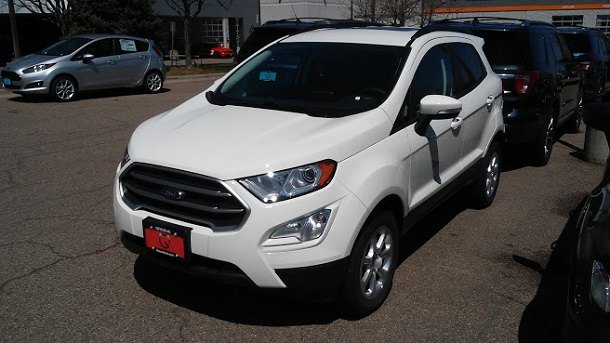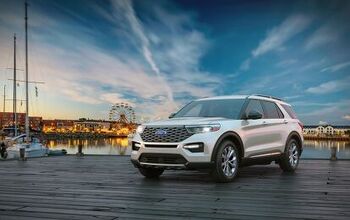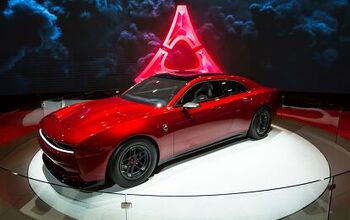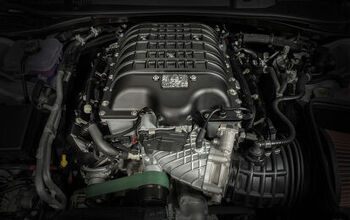Reader Review: Ford's EcoSport is Neither 'Eco' nor 'Sport'
Unless you’re living on Mars, you’ve heard that Ford Motor Company has officially thrown in the towel on the sedan business. It’s a shocking move, but not necessarily a disappointing one, given that the basic versions of those sedans weren’t all that great to begin with. But the performance versions of those sedans are special. If you need a practical, affordable car with a talent for separating you from your driver’s license, Ford has (or had) one for every budget, and that makes it a unique automaker.
But that’s the Old Ford. Apparently, New Ford is all about crossovers, and its newest offering in these parts is the already-sold-overseas Ecosport. Does the EcoSport provide a crystal-ball look into Ford’s future crossovers? For the company’s sake, I hope not.
When Old Ford called a ride “sporty,” it was usually not Don Draper-style bullshit. You’d think, then, that it wasn’t kidding around when it named its new CUV “EcoSport.” Apparently, the joke’s on us. This thing isn’t just non-sporty – it’s almost stubbornly anti-fun, even by the low standards of the tiny-CUV class. It also manages to be silly looking, cramped, unrefined, and overpriced. As a bonus, it isn’t even all that well made.
[Get new and used Ford EcoSport pricing here!]
Let’s start with the styling. We can all agree that making a tiny box on wheels is a stylistic challenge, and yes, this design’s a latecomer to our market, so it’s not the freshest design out there. But there’s no getting around it: Viewed from any angle aside from the front three-quarter, the EcoSport looks too tall, too tippy, and too much like one of those five-buck diecast cars at the grocery store checkout.
Inside, things are a bit better – the design is attractive, and you get a nice set of clearly marked gauges. Control layouts are simple and effective, and while the B&B always argues about whether they like or loathe the iPad-affixed-to-the-dashboard infotainment trend, there’s no arguing how well the EcoSport’s system works – it’s big, bright, clear, fast, and easy to use.
And with that, I’ve run out of nice things to say about the EcoSport’s interior. The seating position is high, as it’s wont to be on cars like this, but the seat itself is flat and not terribly comfortable. Rear-seat passengers are treated like schmucks – with the front seat set for my 5’10” frame, I could barely get my size 13 “Chucks” in and out of the footwells, and once back there, both legroom and kneeroom were in critically short supply. Cargo storage space is adequate, but the tailgate opens horizontally, not vertically, so loading the cargo area will be challenging if you’re parallel parked.
Several TTAC contributors have already commented on the EcoSport’s chintzy-feeling interior trim; having sampled an actual production car that hasn’t been clambered in and out of hundreds of times a day at a car show, I wouldn’t go that far, but neither the materials nor workmanship were particularly impressive. Other details, like the flimsy door handles, the hollow-sounding door slams, and the dust speck I found embedded in the paint of one EcoSport at the dealership (the one on the showroom floor, believe it or not), don’t speak well for this car’s build quality. Time will tell, I suppose.
All of this would probably be a forgivable if the EcoSport killed it in the fun-to-drive department, but if you read my introduction, you already know how this movie ends. Two engines are offered: a turbocharged 1.0 three-banger, and a 2.0-liter naturally aspirated four. All-wheel drive is an option on the four-cylinder version, and you can have any transmission you want, as long as it’s a six-speed automatic (which, thankfully, appears to be of the standard, non-DCT variety). I only sampled the naturally aspirated all-wheel-drive four, and while it’s adequate in stop-and-go traffic, if you drop the hammer at any speed over, say, 35 or 40, all you find is tons of NVH and practically zero acceleration. The culprit is weight: At 3,327 pounds, this thing is 340 pounds heavier than a Focus hatch with the same engine. As a bonus, the drivetrain is coarse and unrefined, and even manages to vibrate the steering wheel noticeably while at idle – a trick I haven’t seen on any car since my ‘81 Rabbit.
I wasn’t able to push the EcoSport I sampled much, but based on the last paragraph, do you think I’d want to? The answer is an emphatic “no,” and you won’t either. The EcoSport’s dinky size makes it easy to whip around in heavy traffic, and ride quality is decent, so I’m sure it’d be just fine for slogging around densely populated city streets – no doubt the environment Ford anticipates most EcoSport owners inhabit. In any other circumstance, this car’s almost maddeningly slow.
That just about covers the “sport” part of the EcoSport’s nametag; what about the “eco” part? Unfortunately, the EcoSport’s fuel economy is almost comically low for such a tiny car – the EPA rates the AWD SE version I drove at 25 mpg city, and 29 highway. Given that you have to flog this thing to get any kind of performance out of it, I suspect those numbers are kind estimates.
Speaking of comedy, let’s talk about EcoSport pricing. A base, FWD version costs $19,995 before tax and delivery; the mid-level AWD SE model I drove stickered out at around $27,000, and loaded versions push $30,000. That’s a lot of money for vehicle that stinks at doing anything but trolling around on city streets; if that’s all you need, then pick out one of the zillion Fiestas your local Ford dealer can’t unload, and save yourself a few grand. If you must succumb to the CUV craze, an AWD Escape comes in at around $25,000, and comes with non-embarrassing styling, the EcoBoost engine, and a back seat fit for actual humans.
I suppose the thing that bothers me most about the EcoSport – aside from the fact that driving it represented a 30-minute investment of my time that I can’t get back – is how half-assed it turned out to be. It’s almost as if Ford, who was late to the tiny-CUV game, plucked this dog off the streets of India (where it’s made), tacked an iPad onto the dash, and figured Americans would buy it for no other reason than our inscrutable desire to drive tiny iPads on wheels that are proportioned like Air Jordan high-top sneakers. If the EcoSport were a Mitsubishi, maybe I’d be less harsh, but we’re talking about Ford, which has shown a real talent for making cars that are relevant to people who love to drive.
If Ford has decided its future is all about crossovers, then that’s its call. But if the only truly good feature on its latest entry into this brave new crossover world is its infotainment screen, I’d say that doesn’t bode well for the Blue Oval.
[Images: Michael Freed]
More by Michael Freed
Latest Car Reviews
Read moreLatest Product Reviews
Read moreRecent Comments
- SCE to AUX Range only matters if you need more of it - just like towing capacity in trucks.I have a short-range EV and still manage to put 1000 miles/month on it, because the car is perfectly suited to my use case.There is no such thing as one-size-fits all with vehicles.
- Doug brockman There will be many many people living in apartments without dedicated charging facilities in future who will need personal vehicles to get to work and school and for whom mass transit will be an annoying inconvenience
- Jeff Self driving cars are not ready for prime time.
- Lichtronamo Watch as the non-us based automakers shift more production to Mexico in the future.
- 28-Cars-Later " Electrek recently dug around in Tesla’s online parts catalog and found that the windshield costs a whopping $1,900 to replace.To be fair, that’s around what a Mercedes S-Class or Rivian windshield costs, but the Tesla’s glass is unique because of its shape. It’s also worth noting that most insurance plans have glass replacement options that can make the repair a low- or zero-cost issue. "Now I understand why my insurance is so high despite no claims for years and about 7,500 annual miles between three cars.





































Comments
Join the conversation
The Fusion is still ranked among the top five vehicles in its class. Ford is delusional if they think Fusion owners will step up to a vehicle like this. As for the Escape the RAV4 is a superior vehicle with class leading reliability. Bye, Bye Ford.
Perhaps like the Asian car companies they will "right size" this vehicle (make it bigger) as they grow the lineup. The Honda Civic is the same size as an older Accord. Everything continues to get bigger. The F-series too.